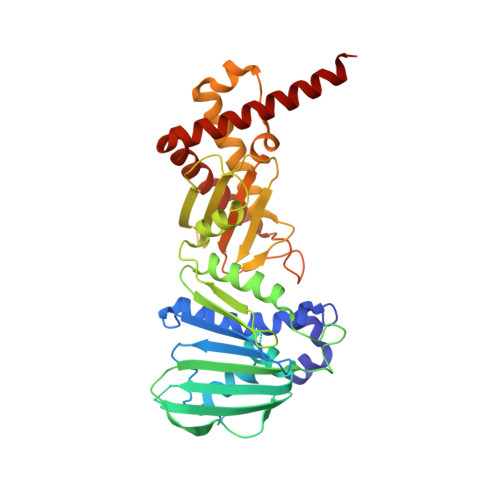N-Phenyl-4,5-dibromopyrrolamides and N-Phenylindolamides as ATP Competitive DNA Gyrase B Inhibitors: Design, Synthesis, and Evaluation.
Zidar, N., Macut, H., Tomasic, T., Brvar, M., Montalvao, S., Tammela, P., Solmajer, T., Peterlin Masic, L., Ilas, J., Kikelj, D.(2015) J Med Chem 58: 6179-6194
- PubMed: 26126187
- DOI: https://doi.org/10.1021/acs.jmedchem.5b00775
- Primary Citation of Related Structures:
4ZVI - PubMed Abstract:
Bacterial DNA gyrase is a well-known and validated target in the design of antibacterial drugs. However, inhibitors of its ATP binding subunit, DNA gyrase B (GyrB), have so far not reached clinical use. In the present study, three different series of N-phenyl-4,5-dibromopyrrolamides and N-phenylindolamides were designed and prepared as potential DNA gyrase B inhibitors. The IC50 values of compounds on DNA gyrase from Escherichia coli were in the low micromolar range, with the best compound, (4-(4,5-dibromo-1H-pyrrole-2-carboxamido)benzoyl)glycine (18a), displaying an IC50 of 450 nM. For this compound, a high-resolution crystal structure in complex with E. coli DNA gyrase B was obtained, revealing details of its binding mode within the active site. The binding affinities of three compounds with GyrB were additionally evaluated by surface plasmon resonance, and the results were in good agreement with the determined enzymatic activities. For the most promising compounds, the inhibitory activities against DNA gyrase from Staphylococcus aureus and topoisomerases IV from E. coli and S. aureus were determined. Antibacterial activities of the most potent compounds of each series were evaluated against two Gram-positive and two Gram-negative bacterial strains. The results obtained in this study provide valuable information on the binding mode and structure-activity relationship of N-phenyl-4,5-dibromopyrrolamides and N-phenylindolamides as promising classes of ATP competitive GyrB inhibitors.
- †Faculty of Pharmacy, University of Ljubljana, Aškerčeva 7, 1000 Ljubljana, Slovenia.
Organizational Affiliation:


















